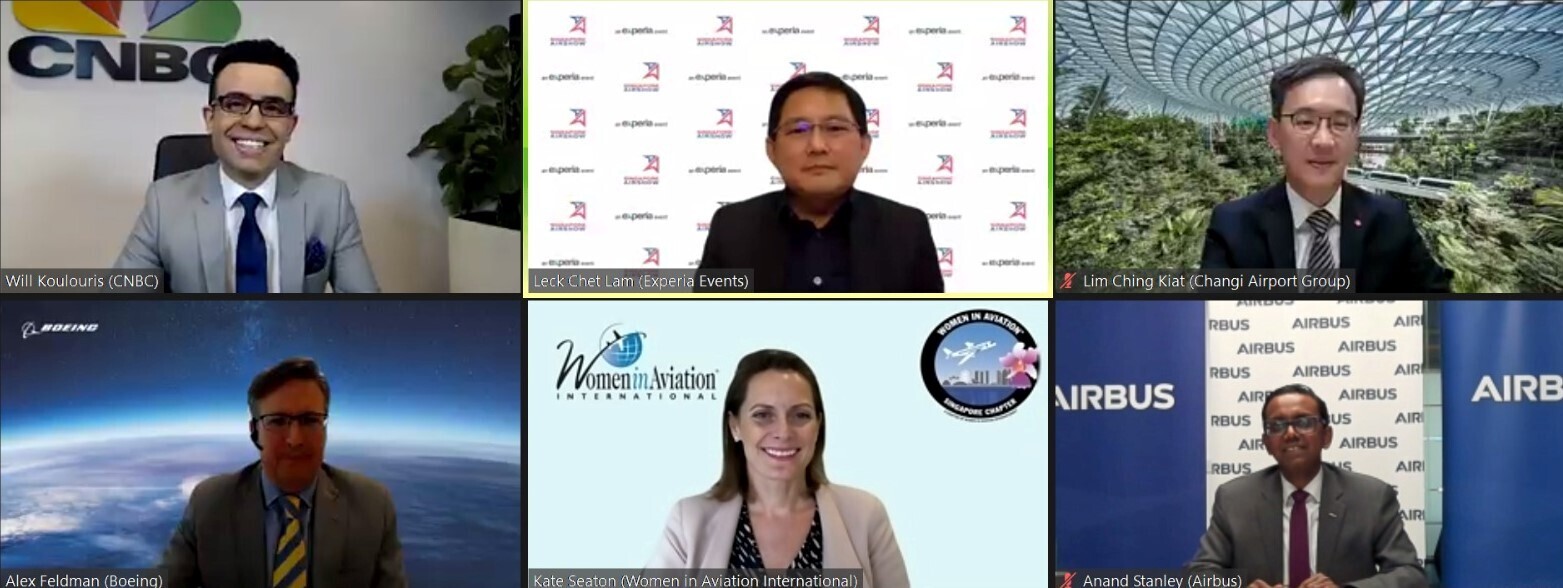
Asia's aviation industry prepares for take-off
Asia's aviation industry prepares for take-off
SHOW NEWS | 27 JANUARY 2022
Industry leaders gather at the inaugural Singapore Airshow Media Roundtable to discuss pertinent issues
Singapore and Asia will play a crucial role in propelling the global aviation industry to pre-pandemic levels and beyond, driving growth for a strong rebound.

|
|---|
That was the consensus of a panel of senior
aviation executives at the inaugural Singapore Airshow Media Roundtable held on
26 Jan 2022, ahead of this year’s Singapore Airshow.
“This region is resilient, and the industry is resilient,” said Boeing Asia Pacific President Alex Feldman. “Naysayers said travel wouldn’t resume after 9/11 and SARS; but it did, and it grew substantially.” Mr Feldman said Boeing sees air travel in Southeast Asia returning to pre-pandemic levels by 2023 or 2024.
The panellists also identified the current disruption as an opportunity for the industry to modernise—by upgrading its fleets, repurposing passenger planes, embracing digitisation, focusing on sustainability and fostering diversity.
Pent-up demand waiting to be unleashed
About a third of Airbus’s global deliveries last year came from Asia, said Airbus Asia-Pacific President Anand Stanley. “Almost 50% of the overall demand [for planes] over the next 20 years comes from the Asia Pacific region,” he said.
“Boeing believes that this region in the world is going to be the growth centre” [SO1] of the industry,” Mr Feldman said. “In fact, we predict that there will be a need for 4,400 new aircraft in the next 20 years in Southeast Asia alone. That's over $700 billion worth of new aircraft at today's prices.”
Many airlines have repurposed airliners for freight, helping to sustain some demand for planes, but a return to travel will be the main driver. Lim Ching Kiat, Changi Airport Group’s Managing Director of Air Hub Development, pointed to Singapore’s reopening as an example of effective management driving demand.
“The first segments we saw were people visiting friends and relatives,” followed quickly by business travel. “Leisure will also come. You can’t zoom a beach on your computer,” said Mr Lim
An opportunity for change
“This crisis has forced the industry to accelerate its pace of change, whether that’s looking at sustainable fuels, a greener industry, or a more diverse workforce,” said Kate Seaton, a board member with Women in Aviation International’s Singapore Chapter and an aviation partner at the law firm HFW in Singapore.
As demand returns and planes are delivered, airlines will need to hire more workers after losing them to industries such as tech, Ms Seaton said.
“Look at women as a means to plug the manpower gaps, particularly on the piloting side,” she said. “At the moment only 6% to 9% of the world’s pilots are female. We hope that over the next three years we will see that increase to 25%.”
The pandemic has also given airlines the opportunity to mothball or get rid of less desirable aircraft.
“During the pandemic we’ve seen a lot of fleet renewal efforts,” Mr Feldman said. “That’s offered an opportunity to retire some of the older and less efficient planes.”
Airbus and Boeing, which have both signed an industrywide pledge, led by IATA, to reach net zero carbon emissions by 2050, are each pursuing low or zero-emissions propulsion technologies including hydrogen, sustainable aviation fuel (SAF) and electric power.
Collaboration and communication are key to industry’s revival
Effective coordination between governments around entry requirements, vaccination records and other travel regulations is crucial to allowing the world to fly again, the panellists said.
“I think there was better coordination as the crisis progressed. In Singapore, the public-private partnership was crucial,” Mr Lim said.
“We salute Singapore for its efforts, but it's got to be more than Singapore,” added Mr Feldman.
Events such as Singapore Airshow help facilitate collaboration within the industry and with stakeholders such as regulators, Experia Managing Director Leck Chet Lam said. “It provides a platform where we can share and learn, to see how we can collectively find ways and means to really navigate us through the pandemic and find solutions, for us to be ready for the recovery and growth,” he added.
“We have to keep communicating about achievements in coordinating and simplifying travel,” added Mr Lim. “We need to re-instil confidence.”
Forging connections at Singapore Airshow
All the participants mentioned Singapore Airshow as both an opportunity to help grow the aviation industry and a symbol of its resilience.
“There's a huge delegation that is coming to this show from Airbus all over the world, from multiple continents,” Mr Stanley said. “We are very excited about the [Singapore] Airshow.”
“Singapore Airshow offers a huge opportunity for all of us to get back together in person,” echoed Mr Feldman.
Singapore Airshow has a critical role to play to facilitate critical dialogues, exchange ideas and showcase solutions. Mr Leck closed the session saying, “Whether it's 60,000, 6,000, 600 or six, it doesn't really change the role of the Airshow; it really creates a platform for us to talk, speak, interact in person.”
Singapore Airshow 2022 will take place from 15-18 February 2022.
